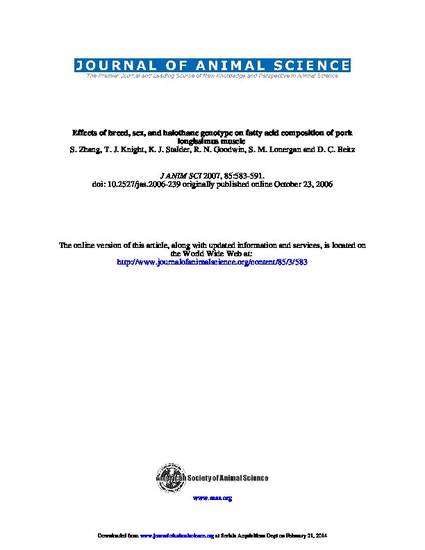
The objective of this study was to estimate the effects of breed, sex, and halothane genotype on fatty acid composition and several fatty acid indices of lipid extracted from porcine LM. Purebred Yorkshire (n = 436), Duroc (n = 353), Hampshire (n = 218), Spotted (n = 187), Chester White (n = 173), Poland China (n = 124), Berkshire (n = 256), and Landrace (n = 187) pigs (n = 1,934; 1,128 barrows and 806 gilts) from 1991, 1992, 1994, and 2001 National Barrow Show Sire Progeny Tests were used. Pigs were classified as the HAL-1843 normal (NN) genotype (n = 1,718) or the HAL-1843 carrier (Nn) genotype (n = 216). For statistical analysis, a mixed model was used that included fixed effects of breed, sex, halothane genotype, test, slaughter date, interaction of breed × sex, and random effects of sire and dam within breed. Breed significantly affected the concentration of individual fatty acids, total lipid content, and the values of several fatty acid indices of LM. Duroc pigs had the greatest (P< 0.01) content of total SFA. Total MUFA concentration in Poland China pigs was greater (P < 0.05) than in all other breeds except the Spotted (P> 0.05). The concentrations of total PUFA were greater (P < 0.01) in Hampshire, Landrace, and Yorkshire pigs compared with those of other breeds. Significant sex differences for individual fatty acids were detected. Compared with gilts, barrows had greater (P < 0.01) concentrations of SFA and MUFA but lower (P < 0.01) total PUFA. Halothane genotype was a significant source of variation for the percentages of some fatty acids. Pigs with the carrier (Nn) genotype had lower concentrations of SFA (P < 0.05) and MUFA (P < 0.01) but a greater concentration of PUFA (P < 0.01) compared with NN pigs. There were significant negative correlations between total lipid content and individual PUFA and significant positive correlations between lipid concentration and most individual SFA and MUFA. In conclusion, the results suggest that breed and sex are important sources of variation for fatty acid composition of LM.
Available at: http://works.bepress.com/steven_lonergan/72/

This article is from Journal of Animal Science 85 (2007): 583–591, doi:10.2527/jas.2006-239. Posted with permission.